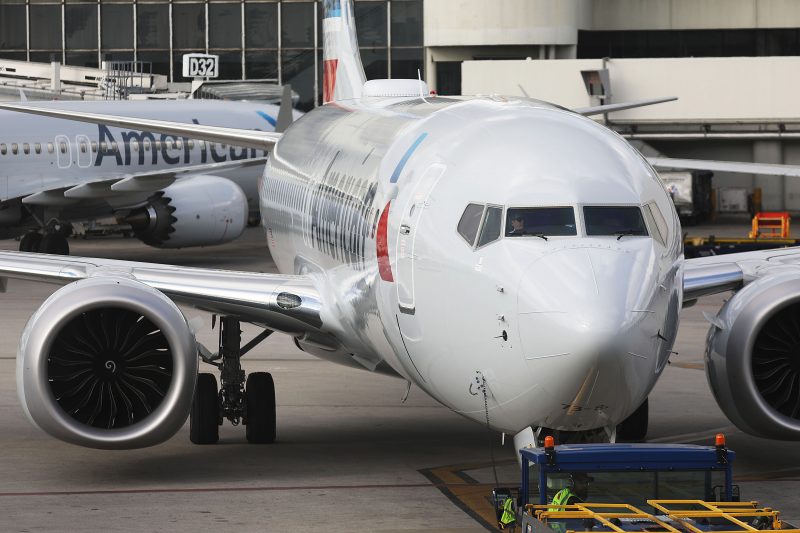Boeing, airlines face tough path after 737 MAX grounding
Boeing 737 MAX 8 aircraft have been grounded around the world following a deadly crash in Ethiopia that killed 157 people (JOE RAEDLE)
Washington (AFP) – Days after the crash of an Ethiopian Airlines 737 MAX 8 that killed 157 people and led to the plane being grounded worldwide, Boeing and commercial airlines are trying to get a handle on the fallout.
Boeing will have to restore confidence in its product, and pay the costs of any modifications, while airlines try to find workarounds to replace the popular aircraft in their lineup of flights.
The US on Wednesday grounded the 737 MAX 8 and MAX 9 models while it continues the search for the cause of the crash, which happened less than five months after a Lion Air plane of the same model went down in Indonesia, killing 189.
Both accidents occurred a few minutes after take-off, a similarity that led authorities around the world to pull the plane out of operation.
The cost for Boeing and the airlines will depend largely on the length of time the planes are out of commission.
How long any reputational damage will endure will depend on how well and how quickly Boeing deals with the a fix, analysts say.
“They will have to convince people to trust them again,” AirInsight’s Michel Merluzeau told AFP.
The 737 MAX is expected to account for more than 90 percent of Boeing’s planned year-end deliveries, so it will want to keep the ban as short as possible.
The company’s shares have fallen 12 percent in the days after Sunday’s crash in Ethiopia, wiping out nearly $30 billion in value, but so far there have been no reports of cancelled orders.
– Safety first –
Boeing has repeatedly said its top-selling 737 MAX planes are safe and reliable, but in the wake of the deadly crash in October, it worked on updating its manual and training.
And following the Ethiopia Airlines accident, the Federal Aviation Administration said it had ordered Boeing to roll out an update to flight software by April.
The Lion Air crash was attributed to the flight stabilization system designed to prevent the aircraft from stalling, the “MCAS,” and the FAA said Wednesday that new evidence and satellite data indicated similarities between the two crashes.
At least four US pilots filed reports following the October crash complaining that the aircraft suddenly pitched downward, according to documents reviewed by AFP on a flight safety database. They overcame the problem by shutting off the autopilot.
One American pilot who flew a MAX 8 on a flight Monday, said while it was “prudent” to ground the planes, he was skeptical about the link between the two crashes.
“There are infinite possibilities that could cause the same symptom,” the pilot, who asked not to be identified, told AFP. “Anything can malfunction.”
But he said guidance issued by Boeing on the MCAS system following the Lion Air crash was quickly incorporated into domestic operations, so “most US pilots would have been able to troubleshoot” the problem if it arose.
Goldman Sachs said that if the problem with the planes is “contained to a software fix, this would likely be a quicker and less costly fix implementation.”
But if there is “a more comprehensive design flaw,” it could be a long and costly issue.
Ken Herbert, analyst at Canaccord, said the cost for a software fix would be around $500 million.
– Replacement planes –
The other major consequence of pulling the planes from service are how the airlines can adjust.
There are about 371 Boeing 737 MAX aircraft in use worldwide, accounting for a small share of the world’s 27,000 commercial planes, according to Richard Aboulafia, an aerospace expert at Teal Group, who said that “replacing them is a temporary problem.”
However, air transport expert Addison Schonland said, “Nobody has ‘extra’ planes.”
Airlines will have to juggle to cover their flights, and reimburse customers if they have to cancel, he said.
“I suspect recently retired aircraft are coming out of the desert now.”
The carriers have the option of leasing replacement jets, and likely would send the bill to Boeing.
Canaccord’s Herbert said the “best case” scenario is six to eight weeks, and meanwhile Boeing “will likely be responsible for the operating difference between MAXs and alternative jets, and for any lease costs for new jets, which could amount to $1 billion.”
American carrier Southwest airlines has the largest fleet of MAX planes in the world, but they make up only 4 percent of its flight program.
“We will complete any previously scheduled MAX 8 flying with other available aircraft in our fleet,” a Southwest spokesman said.
But in Europe, budget airline Norwegian Air Shuttle will fill in with other models, such as the long-haul Dreamliner and the short- and medium-haul Boeing 737-800.
The airline on Wednesday announced that it would ask Boeing for compensation to cover the additional operating costs.
Disclaimer: This story is published from a syndicated feed. Siliconeer does not assume any liability for the above story. Validity of the above story is for 7 Days from original date of publishing. Content copyright AFP.


